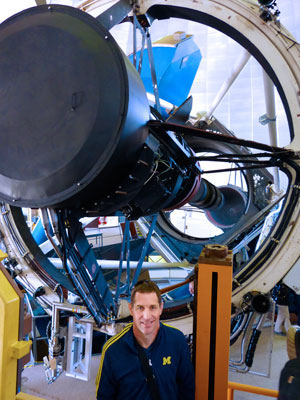Search and Discovery in our Solar System
 Welcome! I'm an astrophysicist who uses the tools of optical astronomy and data science to study minor planets throughout the solar system, with a special focus on the region beyond Neptune. The trans-Neptunian solar system -- which includes the Kuiper Belt, the scattered disk, and exotic distant populations like Inner Oort Cloud objects -- contains thousands of primordial, icy worlds with a wide range of physical and dynamical properties that collectively form an archaeological remnant of the solar system's early history. To discover and study these populations, we employ state-of-the-art techniques to collect and analyze data from telescopes on the ground and in space. In recent years we have obtained data from the 4-meter Blanco telescope and the 6.5 meter Magellan telscopes in Chile, the Subaru 8.5 meter telescope in Hawai'i, the 2.4 meter MDM telescope at Arizona's Kitt Peak, NASAs New Horizons spacecraft, and -- most recently -- the James Webb Space Telescope. Many of these projects have been led by graduate or undergraduate students. We also seek to understand the solar system's formation and evolution through dynamical modeling and simulations. My research is supported by NASA, the National Science Foundation, the Space Telescope Science Institute, and the Southwest Research Institute. Current projects include:
Welcome! I'm an astrophysicist who uses the tools of optical astronomy and data science to study minor planets throughout the solar system, with a special focus on the region beyond Neptune. The trans-Neptunian solar system -- which includes the Kuiper Belt, the scattered disk, and exotic distant populations like Inner Oort Cloud objects -- contains thousands of primordial, icy worlds with a wide range of physical and dynamical properties that collectively form an archaeological remnant of the solar system's early history. To discover and study these populations, we employ state-of-the-art techniques to collect and analyze data from telescopes on the ground and in space. In recent years we have obtained data from the 4-meter Blanco telescope and the 6.5 meter Magellan telscopes in Chile, the Subaru 8.5 meter telescope in Hawai'i, the 2.4 meter MDM telescope at Arizona's Kitt Peak, NASAs New Horizons spacecraft, and -- most recently -- the James Webb Space Telescope. Many of these projects have been led by graduate or undergraduate students. We also seek to understand the solar system's formation and evolution through dynamical modeling and simulations. My research is supported by NASA, the National Science Foundation, the Space Telescope Science Institute, and the Southwest Research Institute. Current projects include:
- The DECam Ecliptic Exploration Project: This project seeks to detect thousands of the faintest Kuiper Belt object ever seen from Earth. Our team was awarded 47.5 nights on the Blanco telescope to carry out this work.
- Distant KBO searches for New Horizons: The New Horizons spacecraft was launched in 2006, explored the Pluto system in 2015, and visited a small Kuiper Belt object (Arrokoth) in 2019. It's now traversing the distant regions of the Kuiper Belt and beyond. We are members of the New Horizons Kuiper Extended Mission (and its successor, KEM2), and are working to identify additional objects that can be observed or potentially visited by the spacecraft.
- Near-Infrared Spectroscopy of Neptune Trojans with JWST: Neptune Trojans are locked in a 1:1 mean-motion resonance with Neptune, and were likely captured during Neptune's outward migration through the planetesimal disk. We are collecting the first-ever reflection spectra of Neptune Trojans to determine their surface composition.
- Data-mining the Dark Energy Survey: The Dark Energy survey, which was carried out on the 4-meter Blanco telescope between 2013-2019, was designed as a cosmological survey, but we realized it had great scientific potential in our own cosmic backyard. We initiated the search for solar system objects in DES data, ultimately making hundreds of discoveries including the dwarf planet candidate 2014 UZ224 ("DeeDee"). We have a few ongoing projects with DES data, including studies of the Trojan populations of Jupiter and Neptune.